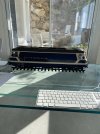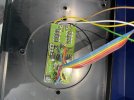Following on from my previous thread. We have two other DC locos, I cannot identify the one in the picture below so cannot find documentation, however for once it proved very easy to dismantle. There are three circuit boards inside, one large and two small, there is no speaker so I assume a non sound board.
I find it strange that a pure DC loco needs so much electronics, it goes forward and back and the lights work with direction none of which is demanding electronically for a DC motor.
I have pictures of the boards, what do the DIP switches do?
I assume control is no different to my old Hornby train set, I could control voltage but nothing else. With my previous post - when the power was applied the engine started there were compressed air sounds, doors closed and the train moved when the driver was ready. In this case I could imagine some electronic circuitry would be required but why so much for this loco?
Is varying voltage the limit of control with a DC loco of this type?
Robin

MOB serial no 20420 - 6 white dots


I find it strange that a pure DC loco needs so much electronics, it goes forward and back and the lights work with direction none of which is demanding electronically for a DC motor.
I have pictures of the boards, what do the DIP switches do?
I assume control is no different to my old Hornby train set, I could control voltage but nothing else. With my previous post - when the power was applied the engine started there were compressed air sounds, doors closed and the train moved when the driver was ready. In this case I could imagine some electronic circuitry would be required but why so much for this loco?
Is varying voltage the limit of control with a DC loco of this type?
Robin

MOB serial no 20420 - 6 white dots



